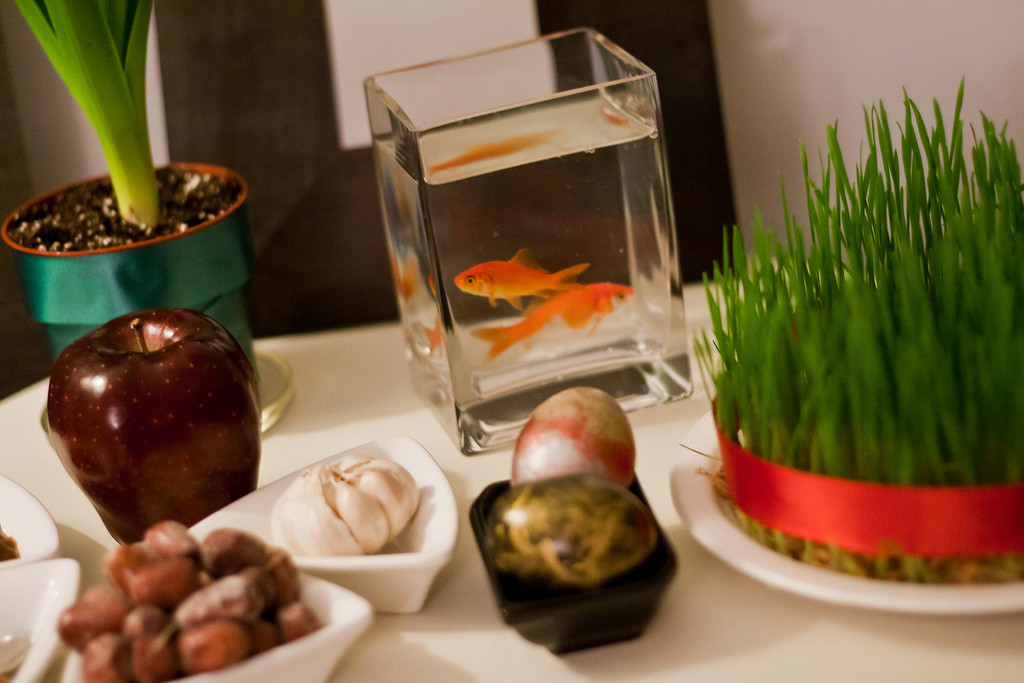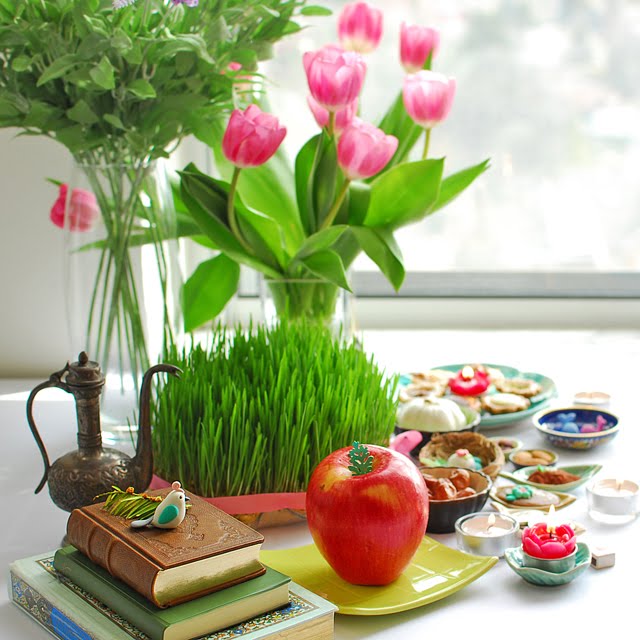 Now Ruz is a celebration that reaffirms our ties to nature and our fellow man. Oh, it’s Haji
Now Ruz is a celebration that reaffirms our ties to nature and our fellow man. Oh, it’s Haji
Firuz, and bright new coins, and visits to the grandparents, and jumping over fires, and much, much more.
But all these are but the concrete manifestations of the heart of Now Ruz-which is to tell us that people and nature are what matter in this life. Now Ruz also stems from an attitude toward time that is in many ways out of date.
To the ancients, time was cyclical. In the modern world, we have developed the idea-some say the god-of progress. With time, our way of life should advance, we say. New inventions will make life easier and open new opportunities. Time is a progression to things new and different, not a cycle that repeats itself. Time marches on, not around.
But, to the ancients, progress was an unknown concept. Time to them was cyclical. For example, there is the 12-year cycle still used from Iran to Japan-the year of the horse, the year of the snake, etc. This is the Year of the Rabbit. In the New World, the ancient Aztecs had a 52-year cycle.
But the most important cycle in the ancient world was the yearly seasonal cycle. That cycle of birth, blossoming, fading and wintry death represented life itself.
Now Ruz marks the beginning of that cycle on the first day of spring. But it is more than just a spring holiday. Now Ruz speaks of the past remembered, the future hoped for, and the present recognized as the foundation of hope.
And, as such, Now Ruz is far more than a mere holiday marked on a solitary day. It is really an entire season that stretches for a month.
The festivities begin about two or three weeks before the day of Now Ruz itself. It starts with house cleaning-or what Americans call spring cleaning. Rooms are swept and washed, fresh flowers brought into the home, and new dresses tailored.
Most significantly, traditional greens-commonly wheat or lentils-are prepared in a dish for sprouting. The ultimate symbol of rebirth and renewal, they will be watched every day for the next few weeks as the seeds turn to small sprouts and then flourish into a tight nest of greenery.
The rites of Now Ruz have grown into a vast tangle of ritual in the millennia over which Now Ruz has been central to the Persian being.
For one thing, the end of the old year means that bad omens and the evil eye must be warded off. That is a task assigned to Chahar Shanbeh Souri, the eve of the last Wednesday of the dying year. The most popular event of that day is the evening burning of heaps of brush, over which young and old leap, singing a refrain that asks the fire to suck away all that is old and sallow and to transfer its brightness and liveliness to the one doing the jumping.
But there are other traditions. According to one, you should drop some blackened old coins into a jug filled with water. Then go to the roof and pitch the jug’s contents over the edge into the street below, while chanting, “My pains and misfortunes into the jug and onto the street.”
Fortunately, this old tradition has not been maintained in cities crowded with high-rise apartment complexes!
Another tradition-one that demands imagination-involves the roof as well. Members of the family go to the roof, make a wish, and drop an object down the rain spout into a jug secured below.
The day after Chahar Shanbeh Souri, the jug is retrieved and the objects in it spread out for all to see. Then a volume of Hafez’s poetry is consulted for each person. The wisdom of Hafez will hint whether one’s wish is to be fulfilled.
Hafez, who wrote in the 14th Century, is noted for verses pregnant with ambiguity. Iranians have long read their problems into, and gotten solutions out of, Hafez’s poetry. The ambiguity for which he is renown allows wide latitude for interpretation. The imaginative father can often enlist Hafez to help him solve some of the growing pains of his children.
Now Ruz day is the culmination of all the preparations. The Haft Seen table is the centerpiece or focal point of the family gathering. It is described in another article in this week’s edition.
As the magic moment approaches when the sun crosses the imaginary line in the sky to shift seasons from winter to spring, the family gathers about the table. Candles equal to the number of offspring are lit. Colored eggs are added to the table. Everyone holds a new coin for good luck. As the seconds tick away, the excitement builds-regardless of age.
Many will hold their breath. For a brief period time seems almost to stand still-even though everyone gathered about the table knows full well that this is the moment when time makes a “dramatic” shift-a shift back to the start of the cycle of life.
It is the dramatic instant when the mystical bull, described in an accompanying article, shifts the earth from one horn to the other. For magical seconds, the Manichean world of opposites-good and evil, light and darkness, the quick and the dead, the worlds of irreconcilable opposites-stand together.
Zoroaster said that, as spring begins, the souls of the dead return to their homes to visit prosperity and happiness upon the living inhabitants. Within an instant, the New Day-the literal translation of Now Ruz-has begun.
This sets off a week-long celebration that is centered around visits to close friends and relatives. It is a mad social whirl. The eldest is always remembered and visited first, as a sign of respect for age. Gifts are exchanged. The visitations to other family members and neighbors and friends cascade through the succeeding days. There is much time for embraces and reminiscing.
The visits themselves reflect the significance of social bonds and the need to put aside the petty frictions that can often infest close relationships. Now Ruz snuffs out the Hatfield-and-McCoy hatreds before they can put down roots.
The season that is Now Ruz finally comes to a formal end on Sizdeh Bedar, the 13th day of the New Year, which falls on Saturday, April 2, this year.
The number 13 is unlucky and the best way to avoid the ill omen of this day is to remain outside. Parks, forests, country roads abound with families enjoying the open air, picnicking, strolling, hiking. Or just sitting in the shade and maybe enjoying a snooze beside a trickling stream.
It is a day for renewing our ties with nature and mankind. In fact, all of Now Ruz is a time for renewing our bonds with the people with whom we live and the planet on which we thrive.
As the holiday season began with the planting of greens in a plate, so it thrived as the shoots grew and nourished. Now the season ends as the shoots are returned to the earth on Sizdeh Bedar.
The new year has begun.
Life continues its cycle of renewal.
Happy Now Ruz to one and all.



















